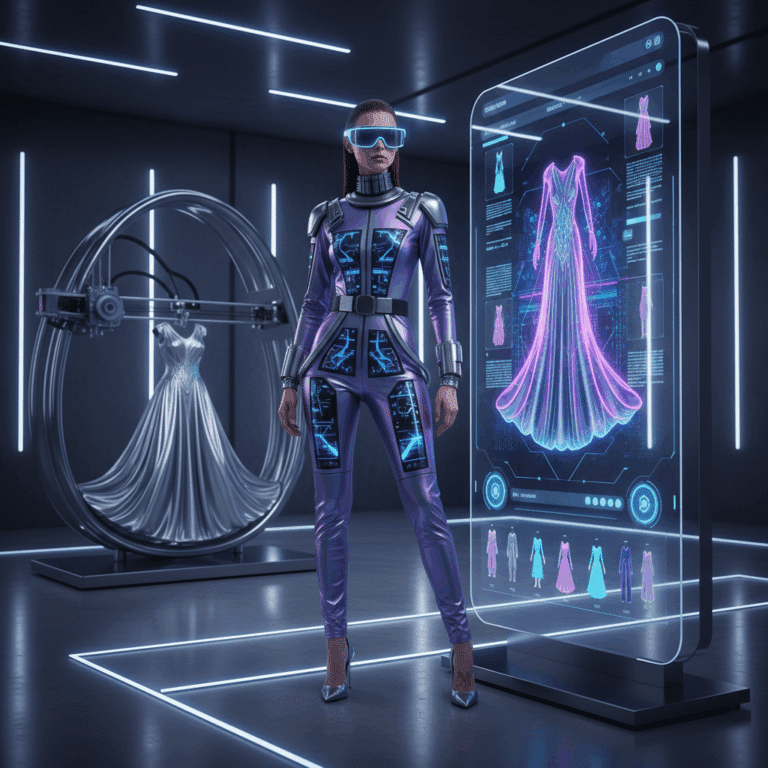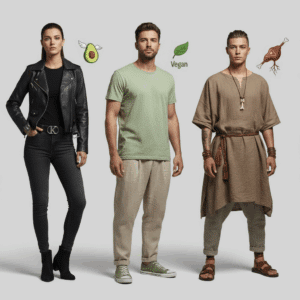Technology Transforming Fashion Design
The fusion of technology and fashion design is reshaping how garments are created, offering innovative tools that enhance creativity and precision. This transformation enables designers to bring ideas to life with unprecedented efficiency.
From virtual fittings to digital prototyping, technology allows for faster, more sustainable development cycles. It reduces waste while providing customers with engaging and personalized experiences.
These advancements not only speed up the design process but also improve the overall quality and fit, ensuring garments meet modern consumer needs effectively.
Virtual Fittings with Augmented Reality
Augmented reality (AR) is revolutionizing how customers interact with fashion by offering virtual fitting rooms. Shoppers can digitally try on clothes in real time, enhancing convenience and engagement.
Brands like Gucci and ASOS have integrated AR try-ons, which help reduce return rates by providing a more accurate preview of how garments fit and look on the user before purchase.
This technology creates an immersive shopping experience, merging physical and digital worlds to meet consumer demand for personalized convenience.
3D Modeling and Digital Prototyping
3D modeling software enables designers to create detailed digital garment versions, allowing instant adjustments to fit and design elements. This speeds up the prototype phase drastically.
Digital prototyping reduces material waste by minimizing the need for physical samples, contributing to more sustainable practices in the fashion industry.
By visualizing garments in three dimensions early, brands can enhance creativity while ensuring that final products meet exact specifications before manufacturing.
Innovations in Fashion Production
Fashion production is evolving with advanced technologies like 3D printing, smart fabrics, and AI. These innovations improve customization, sustainability, and connectivity in garment manufacturing.
Integrating these technologies enables brands to create unique products, optimize resources, and enhance responsiveness to consumer demands, driving a new era of efficient fashion production.
The industry benefits from reduced waste, better quality control, and increasingly personalized offerings, setting new standards for creativity and environmental responsibility.
3D Printing for Custom and Sustainable Products
3D printing is transforming fashion by enabling on-demand production of custom garments and accessories, reducing material waste significantly. This technology offers designers freedom to explore complex shapes and textures.
By producing pieces layer by layer, 3D printing minimizes excess inventory and lowers environmental impact, making the fashion supply chain more sustainable and flexible.
Unique designs that were once impossible to create with traditional methods become feasible, allowing brands to innovate and tailor products precisely to customer needs.
Smart Fabrics and Connected Clothing
Smart fabrics incorporate sensors and technology directly into textiles, expanding the role of clothing beyond aesthetics to include functionality like health monitoring and interactive features.
Connected clothing connects garments to devices or networks, offering users a dynamic experience through real-time data collection and adaptive responses, enhancing comfort and style.
This fusion of fashion and technology creates garments that react to their environment or wearer, opening new possibilities for sportswear, wellness, and everyday apparel markets.
AI-Driven Trend Prediction and Personalization
Artificial intelligence analyzes vast consumer data to forecast trends and tailor fashion collections, allowing brands to meet market demands more accurately and reduce overproduction risks.
AI-powered personalization generates highly customized recommendations and product offerings, enhancing customer satisfaction and fostering loyalty through data-driven insights.
This smart use of data supports efficient inventory management and innovative designs aligned closely with evolving consumer preferences, transforming how fashion brands operate.
Digital Consumer Experience Enhancements
The integration of digital tools in fashion retail is enhancing how consumers shop, offering more interactive and personalized experiences. This evolution is reshaping customer expectations and engagement.
Innovations such as virtual try-ons and gamified shopping blend convenience with entertainment, creating seamless bridges between technology and consumer desires in fashion.
These developments not only improve satisfaction but also help brands reduce returns and build stronger customer relationships through immersive and data-driven approaches.
Virtual Try-Ons and Reduced Returns
Virtual try-ons use augmented reality to enable shoppers to visualize how clothes fit digitally, without physically trying them on. This convenience increases buyer confidence significantly.
By allowing accurate previews of garments, virtual try-ons reduce return rates, benefiting retailers and consumers alike through fewer exchanges and better satisfaction with purchases.
Many brands now embed this technology within apps and websites, creating a more efficient shopping process that aligns with customer expectations for quick, reliable decisions.
Gamified Shopping and Social Media Integration
Gamification adds game-like elements to shopping, making the buying process engaging and fun. It encourages exploration and rewards behaviors, enhancing consumer interaction with brands.
Social media integration allows consumers to share virtual styles and purchase options, increasing visibility and community participation around fashion products and trends.
This synergy between gamification and social platforms drives brand loyalty and word-of-mouth, leveraging digital ecosystems to create vibrant consumer experiences.
Future Impacts of Fashion Technology
The future of fashion technology promises enhanced efficiency and sustainability, driving the industry toward eco-friendly practices and smarter resource use. Innovations will continue to reduce waste and energy consumption.
Simultaneously, the expansion into digital and metaverse spaces offers new avenues for creativity and commerce, blending physical and virtual fashion experiences for consumers worldwide.
These developments will redefine how fashion is produced, marketed, and consumed, making technology a cornerstone for sustainable growth and creative expression.
Efficiency and Sustainability in the Industry
Technology is crucial in creating a more sustainable fashion industry, optimizing resource use and minimizing environmental impact through data-driven production methods.
Automation, AI, and 3D printing enable precise manufacturing that reduces material waste. This shift reflects growing consumer demand for eco-conscious products and ethical practices.
Moreover, digital prototyping and virtual sampling reduce the need for physical samples, lowering carbon footprints and speeding product development cycles sustainably.
Expanding Fashion into Digital and Metaverse Worlds
Fashion is increasingly entering the digital realm, with brands creating virtual clothing and accessories designed for avatars in metaverse platforms and online games.
This expansion opens unique opportunities for interactive marketing, exclusive drops, and digital ownership, driving new business models and immersive consumer experiences.
Interesting Insight: Digital-Only Fashion
Digital-only fashion allows consumers to express style without physical production, significantly reducing environmental impact while tapping into vibrant online communities.
Brands gain creative freedom to experiment with bold, futuristic designs unbound by physical limitations, expanding fashion’s cultural and artistic horizons.






